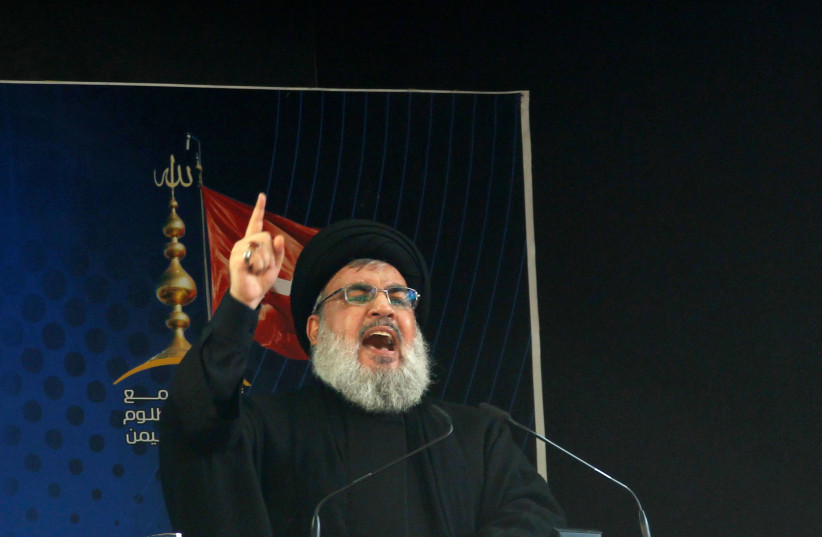Is Israel’s IDF losing its touch in deterring Hezbollah? – Analysis
For the last year or so, Hezbollah has been steadily escalating its provocations against Israel on the Lebanese border.
But in the last two months, and especially this past week, the altercations and provocations spiked to new levels and seem to be catching Israel flatfooted, even as the IDF says it has a strategy and has things under control.
Does it? Or is the IDF still lost about how to handle Hezbollah’s increased aggressiveness?
Part of what has been fascinating about Hezbollah’s approach is that it has been extremely empirical, gradual, and systematic in order to tease out exactly where Israel is weaker and less sure of itself.
This was most prominent with Hezbollah’s establishment of outposts, which The Jerusalem Post has learned was done by accident and initially without Hezbollah Chief Hassan Nasrallah’s knowledge.
 Lebanon’s Hezbollah leader Sayyed Hassan Nasrallah addresses his supporters during a public appearance at a religious procession to mark Ashura in Beirut’s southern suburbs, Lebanon October 12, 2016 (credit: AZIZ TAHER/REUTERS)
Lebanon’s Hezbollah leader Sayyed Hassan Nasrallah addresses his supporters during a public appearance at a religious procession to mark Ashura in Beirut’s southern suburbs, Lebanon October 12, 2016 (credit: AZIZ TAHER/REUTERS)Subsequently, Hezbollah said nothing about the outposts and kept them quiet, with Nasrallah himself avoiding commenting on them for around two months until he was sure that the IDF and the government were worried about confronting him.
Nasrallah was careful not to say a word until after Israel wrote multiple polite requests to the UN to ask it to convince Hezbollah to move and after multiple other Lebanese officials publicly rejected the requests, and the IDF still did nothing.
All of this was occurring in the Mount Dov enclave where the IDF says it has complete control, but where apparently a couple dozen Lebanese were able to infiltrate over the weekend around 80 meters into Israeli territory.
Other Hezbollah provocations
Other recent provocations have included firing tank missiles at Israel’s fence, ripping off Israeli surveillance cameras, and throwing rocks as the IDF tries to build up its fence along the UN-recognized Blue Line border.
Part of the game is that for years, Hezbollah did lower-level provocations or random Lebanese citizens would just walk across the Blue Line, because there was no physical barrier.
This was why around a year ago, the IDF went into higher gear to finish the fence.
However, aside from the new IDF fence extensions limiting Hezbollah’s ability to make trouble and potentially invade with its elite Radwan unit, the fence extensions also sometimes do go slightly onto the Lebanese side of the Blue Line.
According to the IDF, this is never a land grab. It is merely matter-of-fact that the Blue Line was drawn without considering geography and sometimes a fence can only physically be sustained in certain spots.
But Nasrallah’s point in his speech last week was to accuse Israel of having violated the Blue Line more, to try to flip the whole narrative.
What can the IDF really do to the Hezbollah fighters camping out at an outpost a few meters into Israeli territory, nowhere near Israeli civilians, and where the IDF has any possible path they could try to advance further completely cut off?
Israel has always pushed back any invaders and fired back on those who have fired on it, but mostly with kid gloves. Two major drills have or are being held in the North last week and this week. The IDF chief-of-staff Lt.-Gen. Herzi Halevi, IDF intelligence chief Maj.-Gen. Aharon Haliva, and IDF Northern Commander Maj.-Gen. Uri Gordon have all recently spoken about the crisis, visited the North, or both.
And Israel of course has every right to evict them by force. But now that they have been there for two months and are not really a danger, how will the world look at the IDF if there is a blood bath to remove them?
This weekend the IDF was able to get the couple dozen Lebanese to withdraw using non-lethal means. But what if next time some Lebanese infiltrate and are killed, even though they are not armed.
Also, what if some Lebanese get deeper into Israel than 80 meters having learned lessons about how to potentially beat Israel’s non-lethal measures?
The fact is the highest echelons of the IDF are split about whether to remove the Hezbollah outposts by force. For now, the group wanting to wait longer to see if Hezbollah can be convinced to leave, or at least to wait for a quieter moment, is holding sway.
From the number of incidents in which Lebanese are crossing the border, even in significant numbers, or attacking or breaching aspects of the border fence, it is clear that the IDF has not made any huge shift of forces to the North to stop them.
Yet, the IDF remains supremely confident that it has the situation under control.
It is convinced that Nasrallah is still deeply deterred by how hard he and Hezbollah were hit by the IDF during the 2006 Second Lebanon War.
The IDF cites as evidence that all of Nasrallah’s speeches and low-grade gimmicks simply betray that he has not risked a broader conflict with Israel in over 17 years.
Is the IDF right?
Probably the most accurate reading of the current situation is that neither Nasrallah nor the IDF have decided how far they will go or when to risk a bigger conflict.
That is a combustible mix for the coming months.





Comments are closed.